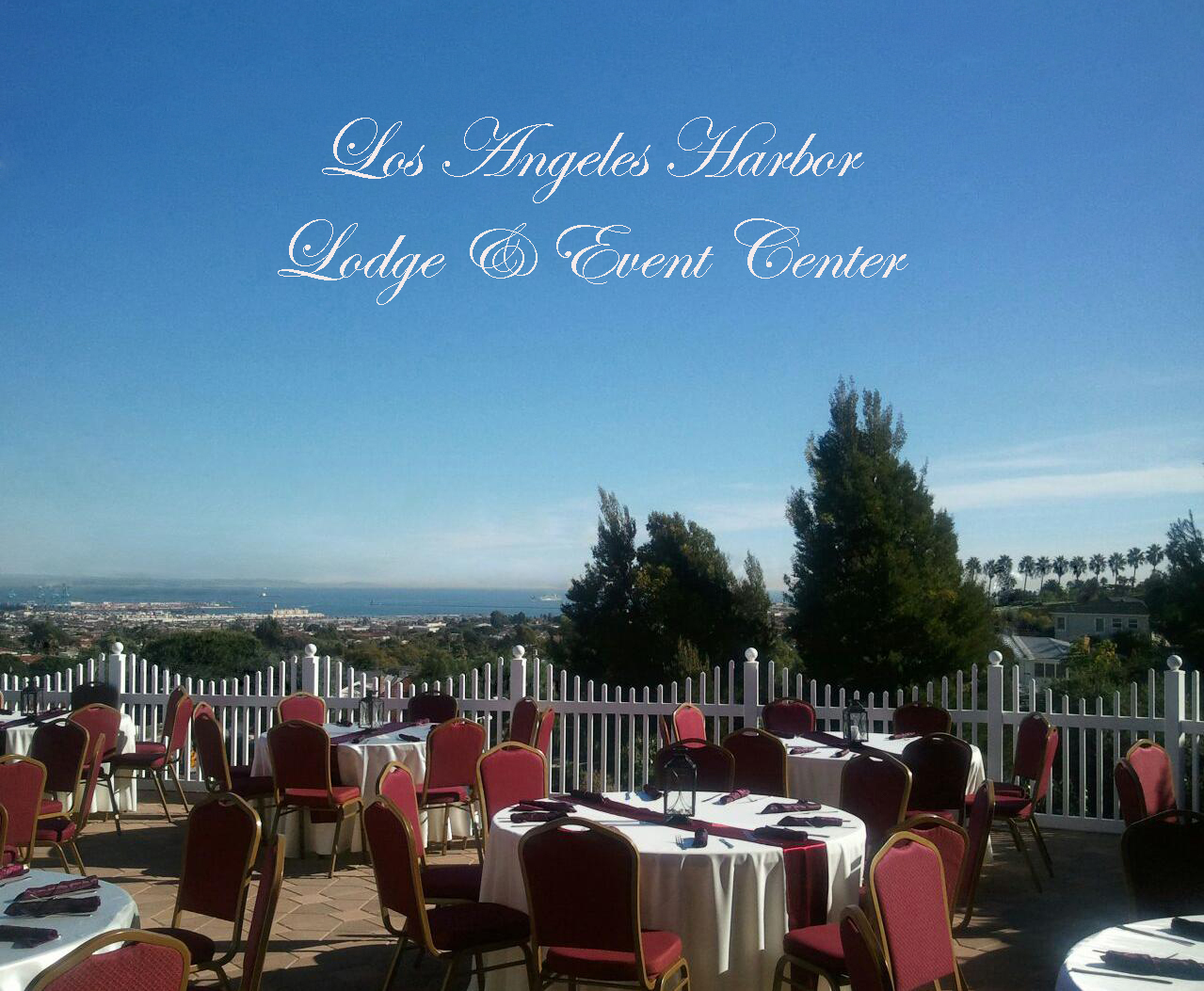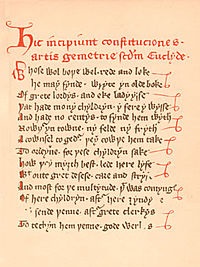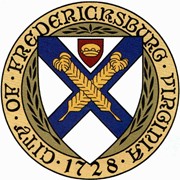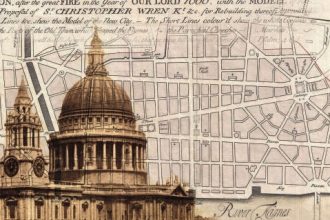In 1757 King George II presented to the British Museum a collection of some 12,000 volumes, the nucleus of which had been laid by King Henry VII and which came to be known as the Royal Library. Among these books was a rarely beautiful manuscript written by hand on 64 pages of vellum, which was catalogued under the title, A Poem of Moral Duties: here entitled Constitutiones Artis Gemetrie Secundem. It was not until Mr. J.O. Halliwell, a non-Mason, chanced to make the discovery that the manuscript was known to be a Masonic document. It is now known as the Regius Manuscript and is the oldest known Masonic document, written in poetic meter and dated to c1390.
The Manuscript is written in Middle English composed of rhyming couplets. In this, it differs from the prose of all the later charges. The poem begins by describing how Euclid “counterfeited geometry” and called it masonry, for the employment of the children of the nobility in Ancient Egypt. It then recounts the spread of the art of geometry in “divers lands.” The document relates how the craft of masonry was brought to England during the reign of King Athelstan (924-939). It tells how all the masons of the land came to the King for direction as to their own good governance, and how Athelstan, together with the nobility and landed gentry, forged the fifteen articles and fifteen points for their rule. This is followed by fifteen articles for the master concerning both moral behavior (do not harbor thieves, do not take bribes, attend church regularly, etc.) and the operation of work on a building site (do not make your masons labor at night, teach apprentices properly, do not take on jobs that you cannot do, etc.). There are then fifteen points for craftsmen which follow a similar pattern. Warnings of punishment for those breaking the ordinances are followed by provision for annual assemblies. There follows the legend of the Four Crowned Martyrs, a series of moral aphorisms, and finally a blessing.
The OLD CHARGES refer to those ancient documents that have come down to us from the 14th century and afterwards in which are incorporated the traditional history, the legends and the rules and regulations of Freemasonry. They are called variously “Ancient Manuscripts,” “Ancient Constitutions,” “Legend of the Craft,” “Gothic Manuscripts,” “Old Records,” etc. The Regius Manuscript is the oldest.
All our constitutions, statutes, laws, rules, by-laws and regulations to some extent or other trace back to the Old Charges. Without them, Masonic jurisprudence, or the methods for governing and regulating the legal affairs of the Craft, would be left hanging suspended in the air. It is believed that these Old Charges were used in making a Mason in the old Operative days; that they served as constitutions of lodges in many cases, and sometimes functioned as what we today call a warrant.
The author furnishes a list of 15 “points” and 15 “articles,” which are quite specific instructions concerning the behavior of a Craftsman. The Articles are the legal regulations and are summarized below.
Article 1. A master mason must be worthy of the confidence of the lords; he must pay the fellows a fair wage with the lord’s money.
Article 2. Every master mason must attend a general assembly, unless he can give a good excuse.
Article 3. A master mason shall not take on an apprentice for less than seven years and must lodge him during his apprenticeship.
Article 4. A master mason must not take any serfs as apprentice.
Article 5. A master mason shall take on neither bastards nor cripples.
Article 6. A apprentice shall be paid less than the fellows, but his salary shall increase as he progresses.
Article 7. A master mason shall employ neither thieves nor murderers.
Article 8. A master mason may discharge an incompetent worker and replace him with another.
Article 9. A master mason must make sure that the foundation of the building is well-laid.
Article 10. A master mason must never take over, or meddle with, the work of another master mason, or be fined a penalty of ten pounds.
Article 11. A mason shall not work at night, except to study.
Article 12. One shall not disparage the work of one’s fellows.
Article 13. A master mason must give his apprentice a complete education.
Article 14. A master mason shall not take on an apprentice unless he has enough work for him.
Article 15. A master mason must not leave his fellows astray, because he must care about their souls.
The Regius Manuscript is the only version of the Old Charges to be written in meter, and may have been composed by a priest. There are some 800 lines in the poem, the strictly Masonic portion coming to an end at line 576, after which begins a “sermonette” on moral duties.
The “sermonette” portion deals with moral duties. They were intended for the gentlemen of those days, and the instruction for behavior would have been out of place in a code of manners drawn up for the use of a Guild or Craft of Artisans. The point of this is that there must have been present among the Craftsmen of that time a number of men not engaged at all in labor, and therefore were, as we would now describe them, “speculatives.” The greatest minds of the period were devoted to architecture, and there is no reason not to believe that among the Craftsmen were members of good families. Therefore, many of its members may well have stood in need of rules for preserving proper decorum in great houses and among the members of the upper classes. The Points were probably not legally binding but were moral regulations, and are summarized below.
1st point. A man of the craft must love God, the church and his fellows.
2nd point. Masons must be paid for holidays.
3rd point. The apprentice must keep secret all that his master tells him and all that he hears or sees in chamber.
4th point. The apprentice shall not be false to his craft, nor to his master or fellows, since the same law as theirs applies to him.
5th point. Masons must receive their salary from their master humbly. The master must discharge a mason before noon if he has no more work for him.
6th point. Quarrels between masons must be settled amicably, after the day’s work is done or on a holiday.
7th point. A mason shall not sleep with the wife of a master nor a fellow’s wife or concubine.
8th point. A master can allow a fellow to mediate between himself and other fellows.
9th point. Fellows must take turns serving at table, buying the food and accounting for what they spent.
10th point. A mason shall not support anyone who persists in wrongdoing; they shall be called before an assembly and excluded from the craft.
11th point. A mason must teach another, whose work is imperfect, in a friendly manner.
12th point. Masters, fellows, lords and local authorities shall agree in assembly to promulgate laws for the craft, and punish those who do not respect them.
13th point. A mason shall never steal, nor be accomplice to a thief.
14th point. A mason must swear to be true to his master, his fellows and his king.
15th point. He who disobeys the laws of the assembly shall be called before it to make amends. If he persists in his fault he shall be excluded from the craft and imprisoned, and his goods confiscated.
The manuscript is believed by many to have been the charges to an initiate as used in the author’s period, and is therefore deemed the most important feature of the book as furnishing us a picture of the regulations of the Craft at that remote date.
by Shawn Donohugh

The author is a Past Master of Moneta Lodge No. 405 (now Gardena-Moneta Lodge No. 372) and a four-time Past Master of Los Angeles Harbor Lodge No. 332. He currently serves as the Secretary of Los Angeles Harbor Lodge No. 332, Secretary of the Southern California Past Master’s Association, is a member of the Grand Lodge of California’s Lodge Support Committee, and served as Senior Grand Deacon for the Grand Lodge of California in 2014-2015.





